
Placoderms are members of the class Placodermi of armoured prehistoric fish, known from fossils, which lived from the Silurian to the end of the Devonian period. Their head and thorax were covered by articulated armoured plates and the rest of the body was scaled or naked, depending on the species. Placoderms were among the first jawed fish; their jaws likely evolved from the first of their gill arches.

Dunkleosteus is an extinct genus of large arthrodire ("jointed-neck") fish that existed during the Late Devonian period, about 382–358 million years ago. It was a pelagic fish inhabiting open waters, and one of the first apex predators of any ecosystem.

Bothriolepis was a widespread, abundant and diverse genus of antiarch placoderms that lived during the Middle to Late Devonian period of the Paleozoic Era. Historically, Bothriolepis resided in an array of paleo-environments spread across every paleocontinent, including near shore marine and freshwater settings. Most species of Bothriolepis were characterized as relatively small, benthic, freshwater detritivores, averaging around 30 centimetres (12 in) in length. However, the largest species, B. rex, had an estimated bodylength of 170 centimetres (67 in). Although expansive with over 60 species found worldwide, comparatively Bothriolepis is not unusually more diverse than most modern bottom dwelling species around today.

Titanichthys is an extinct genus of giant, aberrant marine placoderm from shallow seas of the Late Devonian of Morocco, Eastern North America, and possibly Europe. Many of the species approached Dunkleosteus in size and build. Unlike its relative, however, the various species of Titanichthys had small, ineffective-looking mouth-plates that lacked a sharp cutting edge. It is assumed that Titanichthys was a filter feeder that used its capacious mouth to swallow or inhale schools of small, anchovy-like fish, or possibly krill-like zooplankton, and that the mouth-plates retained the prey while allowing the water to escape as it closed its mouth. A study has since confirmed this assumption as its jaws are functionally closer to that of filter feeders like baleen whales and basking sharks, and it appears to have developed from benthic durophagists that became pelagic suspension feeders. This would make it the first (known) large-sized vertebrate filter feeder. Titanichthys was estimated to have reached a length of 7–7.6 m (23–25 ft), but Engelman (2023) suggested that Titanichthys was comparable in size to Dunkleosteus, likely measuring about or just over 4.1 metres (13.5 ft) in length.
Heintzichthys is an extinct monospecific genus of arthrodire placoderm that lived what is now Europe and North America during the Famennian stage of the Late Devonian period. The type specimen was discovered in the Cleveland Shale near Cleveland, Ohio, in the United States.

Gorgonichthys is extinct monospecific genus of large arthrodire placoderm. Fossils are found in the Upper Famennian Cleveland Shales of Late Devonian in Ohio. The type species is Gorgonichthys clarki.
Guiyu oneiros is one of the earliest articulated bony fish discovered. Fossils of Guiyu have been found in what is now Qujing, Yunnan, China, in late Silurian marine strata, about 425 million years old.

Selenosteidae is an extinct family of small to large-sized arthrodire placoderms from the Late Devonian. With the exception of the Chinese Phymosteus, selenosteids lived in shallow seas in what is now Eastern North America, Eastern Europe, and Northeastern Africa.

Draconichthys elegans a selenosteid arthrodire placoderm from the Late Frasnian Kellwasserkalk facies of the Anti-Atlas Mountains of what is now Morocco. During the Late Devonian, the region would have been a shallow, algae-dimmed sea.
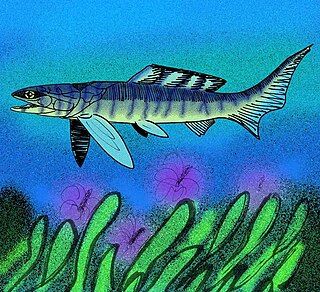
Gymnotrachelus is an extinct monospecific genus of large selenosteid arthrodire placoderm of the Late Devonian known from the Late Famennian Cleveland Shale of Ohio. The type species Gymnotrachelus hydei was originally reconstructed as physically resembling Selenosteus, with slightly smaller orbits. Later specimens led to a reappraisal, and now G. hydei is thought to have a more gar-like or barracuda-like build.

Microsteus is an extinct genus of small selenosteid arthrodire placoderms known from the Upper Frasnian Kellwasserkalk facies of Late Devonian Germany.
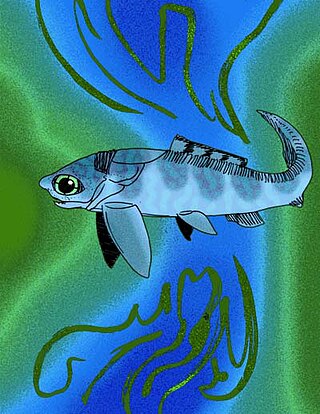
Enseosteus is an extinct genus of small selenosteid arthrodire placoderms known from the Upper Frasnian Kellwasserkalk facies of Late Devonian Germany and Morocco.
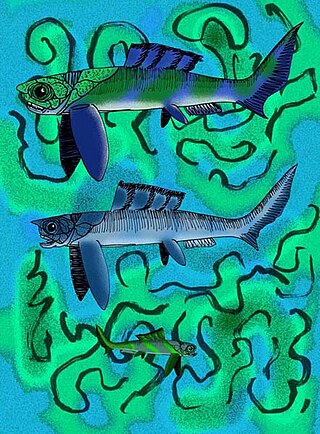
Rhinosteus is an extinct genus of small to medium selenosteid arthrodire placoderms of the Late Devonian known from the Upper Frasnian Kellwasserkalk facies of Bad Wildungen, Germany and Morocco.

Melanomontanosteus is an extinct genus of selenosteid placoderm that lived during the Late Devonian. It contains one valid species, M. occitanus, known from fossils found in Southern France.
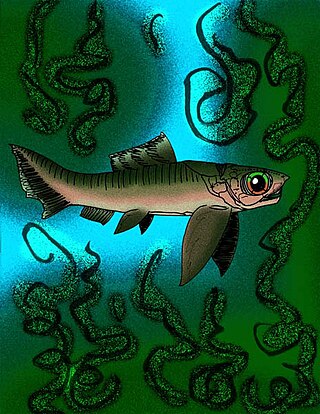
Braunosteus schmidti is a medium-sized selenosteid arthrodire placoderm known from the Upper Frasnian Kellwasserkalk facies of Late Devonian Bad Wildungen, Germany. B. schmidti has a broad skull about 9 centimeters long, and a short, but pointed rostrum. Its appearance is very similar to that of the basal selenosteid Pachyosteus.

Pachyosteus is an extinct monospecific genus of medium-sized selenosteid arthrodire placoderm known from the Upper Frasnian Kellwasserkalk facies of Late Devonian Bad Wildungen, Germany and from the Famennian portions of the Holy Cross Mountains of Poland. The type species Pachyosteus bulla has a broad skull about 7 to 10 centimetres long, a comparatively long median dorsal plate, and a short rostral plate that meets the pineal plate.

The evolution of fish began about 530 million years ago during the Cambrian explosion. It was during this time that the early chordates developed the skull and the vertebral column, leading to the first craniates and vertebrates. The first fish lineages belong to the Agnatha, or jawless fish. Early examples include Haikouichthys. During the late Cambrian, eel-like jawless fish called the conodonts, and small mostly armoured fish known as ostracoderms, first appeared. Most jawless fish are now extinct; but the extant lampreys may approximate ancient pre-jawed fish. Lampreys belong to the Cyclostomata, which includes the extant hagfish, and this group may have split early on from other agnathans.
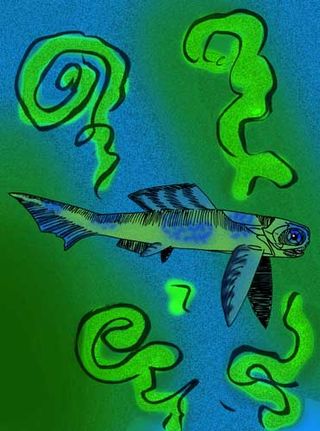
Walterosteus is an extinct genus of small selenosteid arthrodire placoderms known from the Upper Frasnian Kellwasserkalk facies of Late Devonian Germany and Morocco.
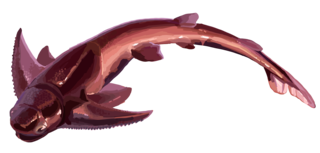
Kujdanowiaspis is an extinct genus of arthrodire placoderm fish from the Early Devonian of Podolia (Ukraine), Poland and Spain. Kujdanowiaspis is known from many fragmentary head shields and body armours.

Alienacanthus is a genus of selenosteid placoderm from the Famennian Ostrówka Quarry in the Świętokrzyskie Mountains, Poland, and Kowala Quarry along with the Maïder Basin in the Anti-Atlas, Morocco. The type and only species is A. malkowskii, known from a handful of specimens.



























